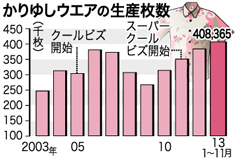Shipping volume of kariyushi shirts exceeds 400,000

Production volume of kariyushi shirts.
December 20, 2013 Ryukyu Shimpo
The annual production volume of kariyushi shirts has exceeded 400,000 items for the first time. According to the Okinawa Clothing Sewing and Manufacturing Industrial Association, the volume of these shirts shipped from January to November 2013 totaled 408,365. This broke the record of 385,965 set in 2012. The shipping volume from November 2012 to August 2013 was up over the same period last year by 30,000 to about 82,000. The overall shipping volume both inside and outside Okinawa has grown because Japanese major companies have promoted the use of kariyushi shirts.
According to the association, production of kariyushi shirts reached 350,000 in 2006 thanks to a campaign started in 2005 to reduce air-conditioner use by encouraging workers to dress lightly during summer. The number of shirts decreased to about 260,000 in 2009, but then recovered to over 300,000 in 2010.
After the Great East Japan Earthquake, companies promoted a campaign to encourage dressing lightly, leading to an increase in shipping and production volume.
JFE Engineering introduced kariyushi shirts as their work dress from this July. This meant that 3,000 employees in the main office in Yokohama and 12 branches nationwide from Hokkaido to Kyushu, and 12 other companies in the group started using the shirts. They ordered about 10,000 shirts from Okinawan companies in April in an attempt to save energy and improve efficiency.
Production volume of long-sleeved kariyushi shirts has also been increasing. Akihiko Higa, the chief researcher of the Project Support Division of Kaiho-soken said, “So far, long-sleeved shirts have been an untapped market. Momentum will gather if a campaign starts to encourage changing to long-sleeved kariyushi shirts on November 1, the day employees change to winter clothes. Then production of long-sleeved kariyushi shirts will increase further.”
(English translation by T&CT, Lima Tokumori and Mark Ealey)
Previous Article:Extra edition:Okinawa Governor approves Henoko landfill for relocation of U.S Futenma base
Next Article:Okinawan player comes second in World Harmonica Festival
[Similar Articles]
- Shipping volume of kariyushi shirts expected to exceed 400,000 items in 2013
- Thousands of Yokohama company employees wear kariyushi shirts
- Kariyushi shirts allowed and jacket not required in lower-house plenary session
- Chibana Hanaui to produce kariyushi shirts to increase popularity
- Pumpkin production revives
 Webcam(Kokusai Street)
Webcam(Kokusai Street)


